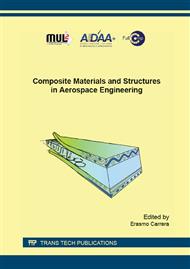[1]
A.P. Mouritz, Review of z-pinned composite laminates, Comp A. 38 (2007) 2383-2397.
Google Scholar
[2]
K.L. Rugg, B.N. Cox, R Massabò, Mixed mode delamination of polymer composite laminates reinforced through the thickness by z-fibres, Comp A. 33 (2002) 177-190.
DOI: 10.1016/s1359-835x(01)00109-9
Google Scholar
[3]
M. Grassi, X. Zhang, Finite element analyses of mode I interlaminar delamination in z-fibre reinforced composite laminates, Comp Sci & Tech. 63 (2003) 1815-1832.
DOI: 10.1016/s0266-3538(03)00134-9
Google Scholar
[4]
W. Yan, H-Y. Liu, Y-W. Mai, Numerical study of the mode I delamination toughness of z-pinned laminates, Comp Sci & Tech, 63 (2003) 1481-1493.
DOI: 10.1016/s0266-3538(03)00167-2
Google Scholar
[5]
H-Y. Liu HY, W. Yan, X-Y. Yu, Y-W. Mai YW, Experimental study on effect of loading rate on mode I delamination of z-pin reinforced laminates. Comp Sci & Tech. 67 (2007) 1294–1301.
DOI: 10.1016/j.compscitech.2006.10.001
Google Scholar
[6]
D.D.R. Cartié, M. Troulis, I.K. Partridge, Delamination of z-pinned carbon fibre reinforced laminates. Comp. Sci. Tech. 66 (2006) 855-861.
DOI: 10.1016/j.compscitech.2004.12.018
Google Scholar
[7]
A.P. Mouritz, Delamination properties of z-pinned composites in hot-wet environment, Comp A. 52 (2013) 134-142.
DOI: 10.1016/j.compositesa.2013.03.010
Google Scholar
[8]
X. Zhang, L. Hounslow, M. Grassi, Improvement to low-velocity impact and compression-after-impact performance of z-fibre pinning, In: Proceedings of the 13th International Conference on Composite Materials, July 2003, San Diego.
DOI: 10.1016/j.compscitech.2006.02.029
Google Scholar
[9]
M.D. Isa, S. Feih, A.P. Mouritz, Compression fatigue properties of quasi-isotropic z-pinned carbon/epoxy laminate with barely visible impact damage. Comp Struct. 93 (2011) 2222-2230.
DOI: 10.1016/j.compstruct.2011.03.015
Google Scholar
[10]
D.D.R. Cartié, J-M. Laffaille, I.K. Partridge IK, A.J. Brunner, Fatigue delamination behaviour of unidirectional carbon fibre/epoxy laminates reinforced by Z-Fiber® pinning, Eng Frac Mech. 76 (2009) 2834-2845.
DOI: 10.1016/j.engfracmech.2009.07.018
Google Scholar
[11]
A.Y. Zhang, H-Y Liu, A.P. Mouritz, Y-W. Mai, Experimental study and computer simulation of z-pin reinforcement under cycle fatigue, Comp A. 39 (2008) 406-414.
DOI: 10.1016/j.compositesa.2007.09.006
Google Scholar
[12]
K. Pingkarawat, A.P. Mouritz, Improving the mode I delamination fatigue resistance of composites using z-pins, Comp Sci Tech. 92 (2014) 70-76.
DOI: 10.1016/j.compscitech.2013.12.009
Google Scholar
[13]
F. Pegorin, K. Pingkarawat, S. Daynes, A.P. Mouritz, Mode II interlaminar fatigue properties of z-pinned carbon fibre reinforced epoxy composites, Comp A. 67 (2014), 8-15.
DOI: 10.1016/j.compositesa.2014.08.008
Google Scholar
[14]
F. Pegorin, K. Pingkarawat, S. Daynes, A.P. Mouritz, Influence of z-pin length on the delamination toughness and fatigue resistance of pinned composites, Comp B. 78 (2015) 298-307.
DOI: 10.1016/j.compositesb.2015.03.093
Google Scholar
[15]
F. Pegorin, K. Pingkarawat, A.P. Mouritz, Comparative study of the mode I and II delamination fatigue properties of z-pinned aircraft composites, Mat & Design. 15 (2015) 139-146.
DOI: 10.1016/j.matdes.2014.08.072
Google Scholar
[16]
A.P. Mouritz, B.N. Cox, A mechanistic interpretation of the comparative in-plane mechanical properties of 3D woven, stitched, and pinned composites, Comp A. 41 (2010) 709-728.
DOI: 10.1016/j.compositesa.2010.02.001
Google Scholar
[17]
P. Chang, A.P. Mouritz, B.N. Cox, Properties and failure mechanisms of z-pinned laminates in monotonic and cyclic tension, Comp A. 37 (2006) 1501-1513.
DOI: 10.1016/j.compositesa.2005.11.013
Google Scholar
[18]
A.P. Mouritz, Tensile fatigue properties of 3D composites with through-thickness reinforcement, Comp Sci Tech. 68 (2008) 2503-2510.
DOI: 10.1016/j.compscitech.2008.05.003
Google Scholar
[19]
A.P. Mouritz, P. Chang, Tension fatigue of fibre-dominated and matrix-dominated laminates reinforced with z-pins, Int J Fatigue. 32 (2010) 650-658.
DOI: 10.1016/j.ijfatigue.2009.09.001
Google Scholar
[20]
A.P. Mouritz, Compression properties of z-pinned composite laminates, Comp Sci Tech. 67 (2007) 3110-3120.
DOI: 10.1016/j.compscitech.2007.04.017
Google Scholar
[21]
P. Chang, A.P. Mouritz, B.N. Cox, Flexural properties of z-pinned laminates, Comp A. 38 (2007) 224-251.
Google Scholar
[22]
A.P. Mouritz, P. Chang, M.D. Isa, Z-pin composites: Aerospace structural design considerations, J Aero Eng. 24 (2011) 425-432.
DOI: 10.1061/(asce)as.1943-5525.0000078
Google Scholar
[23]
C.A. Steeves, N.A. Fleck. In-plane properties of composite laminates with through-thickness pin reinforcement, Int. J. Solids Struct. 43 (2006) 3197-3212.
DOI: 10.1016/j.ijsolstr.2005.05.017
Google Scholar
[24]
T.K. O'Brien, R. Krueger. Influence of compression and shear on the strength of composite laminates with z-pinned reinforcement, App Comp Mat., 13 (2006) 173-189.
DOI: 10.1007/s10443-005-9005-4
Google Scholar
[25]
M. Hojo, T. Ando, M. Tanaka, T. Adachi, S. Ochiai, Y. Endo, Modes I and II interlaminar fracture toughness and fatigue delamination of CF/epoxy laminates with self-same epoxy interleaf. Int J Fatigue. 28 (2006) 1154–1165.
DOI: 10.1016/j.ijfatigue.2006.02.004
Google Scholar


